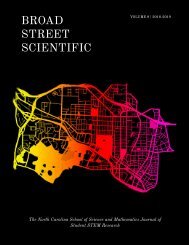Broad Street Scientific Journal 2020
Create successful ePaper yourself
Turn your PDF publications into a flip-book with our unique Google optimized e-Paper software.
hours to stress bacteria into forming biofilms [9]. The biofilm
mass was quantified by Crystal Violet staining. The
plates were first washed with deionized water three times.
They were then stained with 2 mL of 0.1% Crystal Violet
solution for 20 minutes. The dye not associated with the
biofilm was washed out with deionized water. All the dye
associated with the biofilm was dissolved in 1 mL of 33%
acetic acid. The absorbances of these acetic acid and dye
samples were taken at 570 nm by a spectrophotometer.
The optical density (OD) was used as a means to quantify
the biofilm. This experiment was carried out 6 times with
6 replicated wells per plate.
2.4 – Multiple Compounds Biofilm Formation Assay
This experiment determined the effect of combinations
of quorum quenching compounds. This was the same assay
as Individual Compound Biofilm Formation Assay except
each well received 1.32 µL of DMSO as a control, 6.25
µg/mL of naringenin,12.5 µg/mL of neohesperidin, 13.22
µg/mL of cinnamaldehyde, or a combination of the compounds.
Combinations tested include cinnamaldehyde/
naringenin and neohesperidin/naringenin. Half concentrations
of naringenin (3.125 µg/mL) and cinnamaldehyde
(6.61 µg/mL) were tested in later combinations to determine
whether a synergistic effect was present. Plates were
stained with Crystal Violet and the OD associated with
biofilm was measured. Each combination experiment was
replicated 3 times with 4 replicated wells per plate.
2.5 – Cellular Growth Assay
This experiment determined whether combinations of
compounds altered the growth rates of the bacteria. Overnight
culture of V. harveyi BB120 was diluted in a 1:100 ratio
in Luria Marine (LM) media. Each tube received either
3.97 µL of DMSO as a control, 6.25 µg/mL of naringenin
and 12.5 µg/mL of neohesperidin, 6.25 µg/mL of naringenin
and 13.22 µg/mL of cinnamaldehyde, or 6.25 µg/mL
of naringenin, 12.5 µg/mL of neohesperidin and 13.22 µg/
mL of cinnamaldehyde. The cultures were grown for 24
hours at 30°C with shaking. Optical densities of the broth
were taken roughly every 2 hours for the first 8 hours.
Additionally, samples were taken of the broth at 6 hours
and 24 hours. The samples were serially diluted and plated
on LM agar plates and colony forming units were counted
after 24 hours of growth. This experiment was replicated
twice.
3. Data Analysis
To analyze the results of my experiments, the statistical
software JMP 10 was used to run ANOVA tests and
first determine the presence of a treatment effect. If the
ANOVA test showed an effect, a Tukey’s Honest Significance
Difference (HSD) test was conducted to discern the
significant differences among means. Some data were ad-
ditionally graphed as percent biofilm inhibition, further
emphasizing the presence of a synergistic effect. Biofilm
inhibition percentages were calculated as (control OD -
treatment OD)/(control OD)*100.
4. Results
4.1 – Individual Compound Biofilm Formation Assay
To measure the effectiveness of individual plant-derived
compounds on quorum sensing inhibition, the individual
compound biofilm formation assay was conducted
on V. harveyi biofilms. As determined by the Tukey’s honest
significance test, naringenin at a concentration of 6.25
µg/mL significantly decreased biofilm mass. Cinnamaldehyde
and neohesperidin showed no detectable biofilm inhibition
(Fig 2).
Figure 2. Individual Compound Biofilm Formation
Assay. Shows the results of the individual plant-derived
compounds on biofilm formation in V. harveyi
to see which compounds were most effective. Error
bars show mean +/- 1 SEM. An ANOVA test was conducted
and showed p < 0.0037* (Table 1). A Tukey’s
Significance test was then conducted. Different
letters correspond to significant differences as discerned
by Tukey’s HSD test.
Table 1. ANOVA table from the Individual Compound
Biofilm Formation Assay (Fig. 2).
Source DF Sum of
Squares
Compound
Mean
Square
F Ratio
Prob > F
3 0.34467 0.11489 6.2299 0.0037*
Error 20 0.36883 0.018442
Corr.
Total
23 0.7135
4.2 – Multiple Compounds Biofilm Formation Assay
Because naringenin was consistently effective, combinations
with naringenin were tested. The cinnamaldehyde
and naringenin combination (Fig. 3a) showed a significant
20 | 2019-2020 | Broad Street Scientific BIOLOGY




